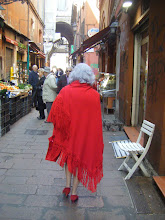
This is the front entrance to the Tate Britain. I love the columns and neoclassical facade. The best part about the inside of the museum, though? Very few visitors. I usually had entire rooms to myself, which made for excellent viewing opportunities.

The Cholmondeley Sisters, circa 1600. This is arguably the most famous painting in the museum. However, when I asked the assistant behind the Info Desk where the painting was located, I was met with a blank stare. That would be akin to walking into the Louvre and being met with a confused look upon asking where one might find the Mona Lisa. Fortunately, it was very easy to find this painting. Although the sisters look as if they are wearing the same outfit, there are actually tiny differences in their clothing if seen close-up.

"Titania and Bottom," depicting a scene from a Midsummer Night's Dream. Here, Titania has fallen under the influence of Bottom. This painting is one in a series of works illustrating scenes from the play by artist Henry Fuseli.

This is another painting illustrating a character from a Shakespeare play. It is Ariel in The Tempest, a character that I had the pleasure of portraying in a small classroom production of The Tempest in college. I was the best sprite ever.

I love this painting of two dogs because it was painted by observing the real-life dogs in a formal sitting. I'm already looking to commission a similarly talented artist to paint a portrait of my beloved chihuahua.

Sheep grazing in the countryside. Is there anything more quintessentially English than that?

"The Annunciation," depicted in a new interpretation by Dante Gabriel Rossetti. His sister, the poet Christina Rossetti ("The Goblin Market"), posed as Mary.

"Ophelia" by Sir John Everett Millais, depicting Ophelia allowing herself to drown after slipping while picking flowers. The flowers have special symbolism: the poppies represent death, daisies innocence, and pansies love in vain. I love this painting.

No comments:
Post a Comment